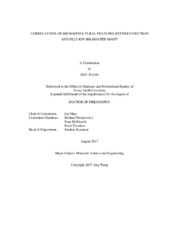| dc.contributor.advisor | Shao, Lin | |
| dc.creator | Wang, Jing | |
| dc.date.accessioned | 2018-02-05T16:49:38Z | |
| dc.date.available | 2019-08-01T06:51:37Z | |
| dc.date.created | 2017-08 | |
| dc.date.issued | 2017-06-05 | |
| dc.date.submitted | August 2017 | |
| dc.identifier.uri | https://hdl.handle.net/1969.1/165737 | |
| dc.description.abstract | Nuclear energy is a sustainable, efficient, carbon-neutral energy source to meet the ever-increasing global energy demands. Some current advanced reactor concepts require reactor core components, such as fuel cladding and ducts, to withstand up to 300–500 dpa neutron irradiation. Achieving such a dose level in test reactors would require years or even decades of radiation, which makes reactor irradiation impractical for materials development and testing. As an alternative approach to study high-dose irradiation effects in materials, ion irradiation techniques are regaining popularity due to their high damage production rate. To date, the correspondence between neutron and ion irradiation is still being investigated, and correlations of microstructural features between neutron and ion irradiated materials are still not well understood.
As a means to understand these correlations, the microstructures of neutron- and ion-irradiated steel alloy MA957 were examined and compared. This material was selected due to its high relevance to high-dose applications. The characterization relies heavily on atom probe tomography (APT). The results show that YTiO oxide particles in MA957 followed similar trends with irradiation temperature after neutron and ion irradiation but size and number density were not identical. The presence of alpha-prime phase has been confirmed at lower irradiation temperatures in both neutron and ion irradiations. Assessing effects on grain boundary segregation after ion irradiation is more challenging. Thus, only qualitative comparisons of segregation of Cr, Ti, and TiO were conducted between neutron and ion irradiation.
Rate theory calculations were carried out to investigate precipitate stability. The defect balance equation and precipitate stability models were reanalyzed using materials-specific and experiment-specific parameters. Precipitate nucleation was not included in the analysis, and so size change is more readily predicted with this model than number density change. Predicted results of particle stability were found to be in good agreement with our experimental results. The ratio of diffusivity to dose rate was identified as a probable measure to determine whether application of temperature shift is necessary for reproducing microstructural evolution in ion irradiation. The dose rate dependence has been reanalyzed and temperature ranges where precipitate growth is independent of dose rate have been identified for future investigations. | en |
| dc.format.mimetype | application/pdf | |
| dc.language.iso | en | |
| dc.subject | Neutron irradiation | en |
| dc.subject | Ion irradiation | en |
| dc.subject | Atom probe tomography | en |
| dc.subject | Oxide-dispersion strengthened alloy | en |
| dc.subject | MA957 | en |
| dc.title | Correlations of Microstructural Features between Neutron and Self-ion Irradiated MA957 | en |
| dc.type | Thesis | en |
| thesis.degree.department | Materials Science and Engineering | en |
| thesis.degree.discipline | Materials Science and Engineering | en |
| thesis.degree.grantor | Texas A & M University | en |
| thesis.degree.name | Doctor of Philosophy | en |
| thesis.degree.level | Doctoral | en |
| dc.contributor.committeeMember | Demkowicz, Michael | |
| dc.contributor.committeeMember | McDeavitt, Sean | |
| dc.contributor.committeeMember | Tsvetkov, Pavel | |
| dc.type.material | text | en |
| dc.date.updated | 2018-02-05T16:49:39Z | |
| local.embargo.terms | 2019-08-01 | |
| local.etdauthor.orcid | 0000-0002-6025-0322 | |


